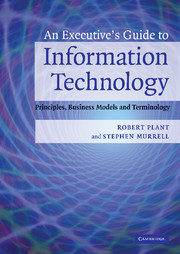Book contents
- Frontmatter
- Contents
- Introduction
- A ACM (Association for Computing Machinery) to Audio
- B Backup to Business process re-engineering
- C C, C++, C# to Cracking
- D Database to Dynamic web pages
- E e-Commerce/e-business to European Union Directive on Privacy and Electronic Commerce 2002
- F Fiber optics to Fuzzy logic
- G to H Global positioning system to Hypertext, HTML
- I ICANN (Internet Corporation for Assigned Names and Numbers) to ISP (Internet service provider)
- J to L Java to Logic programming
- M Machine learning to Multicast
- N Natural language processing (NLP) to Normalization
- O Object-oriented to Outsourcing
- P Packet switching and circuit switching to Public key-private key
- Q to R Quantum computing to RSS (Really simple syndication)
- S Sarbanes-Oxley Act of 2002 (SOX) to Structured design methodologies
- T to U T-Carrier to URL (Uniform resource locator)
- V Value added network (VAN) to Voice over IP (VoIP)
- W W3C (the World Wide Web Consortium) to WYSIWYG
- X to Z X.12 to Zip
- Index
- References
C - C, C++, C# to Cracking
Published online by Cambridge University Press: 17 May 2010
- Frontmatter
- Contents
- Introduction
- A ACM (Association for Computing Machinery) to Audio
- B Backup to Business process re-engineering
- C C, C++, C# to Cracking
- D Database to Dynamic web pages
- E e-Commerce/e-business to European Union Directive on Privacy and Electronic Commerce 2002
- F Fiber optics to Fuzzy logic
- G to H Global positioning system to Hypertext, HTML
- I ICANN (Internet Corporation for Assigned Names and Numbers) to ISP (Internet service provider)
- J to L Java to Logic programming
- M Machine learning to Multicast
- N Natural language processing (NLP) to Normalization
- O Object-oriented to Outsourcing
- P Packet switching and circuit switching to Public key-private key
- Q to R Quantum computing to RSS (Really simple syndication)
- S Sarbanes-Oxley Act of 2002 (SOX) to Structured design methodologies
- T to U T-Carrier to URL (Uniform resource locator)
- V Value added network (VAN) to Voice over IP (VoIP)
- W W3C (the World Wide Web Consortium) to WYSIWYG
- X to Z X.12 to Zip
- Index
- References
Summary
Foundation concept: Programming language.
Definition: Standard, general-purpose programming languages.
Overview
The evolution of programming languages is a short but very complex story. By the mid 1970s the design of mainstream programming languages had branched in two directions: the general-purpose programming languages and the systems programming languages. General-purpose languages were strongly oriented towards supporting reliable software development; the structure of the languages corresponded closely to the structure of a good top-down design, providing programmers with a built-in framework for safe and verified construction; they were able to provide useful warnings about some of the most common things that could go wrong in a program's design before it is ever run, and they made many of the most troublesome of programmer errors impossible.
Unfortunately, what was good for general software development was not always good for low-level, or systems, programming. Implementors of operating systems, compilers, and hardware-monitoring software sometimes have to perform exactly the kind of low-level machine-oriented operations that are so strongly discouraged by the standards of good software development, and programming languages that enforce those standards are made almost unusable for such purposes.
As a result, the systems programming language branch of parallel evolution was also constructed. The essential feature of a systems programming language is that a programmer should be able to give any commands that the computer is capable of obeying, and not have to fight against builtin safety features if those commands do not satisfy some safety standard.
- Type
- Chapter
- Information
- An Executive's Guide to Information TechnologyPrinciples, Business Models, and Terminology, pp. 46 - 87Publisher: Cambridge University PressPrint publication year: 2007



